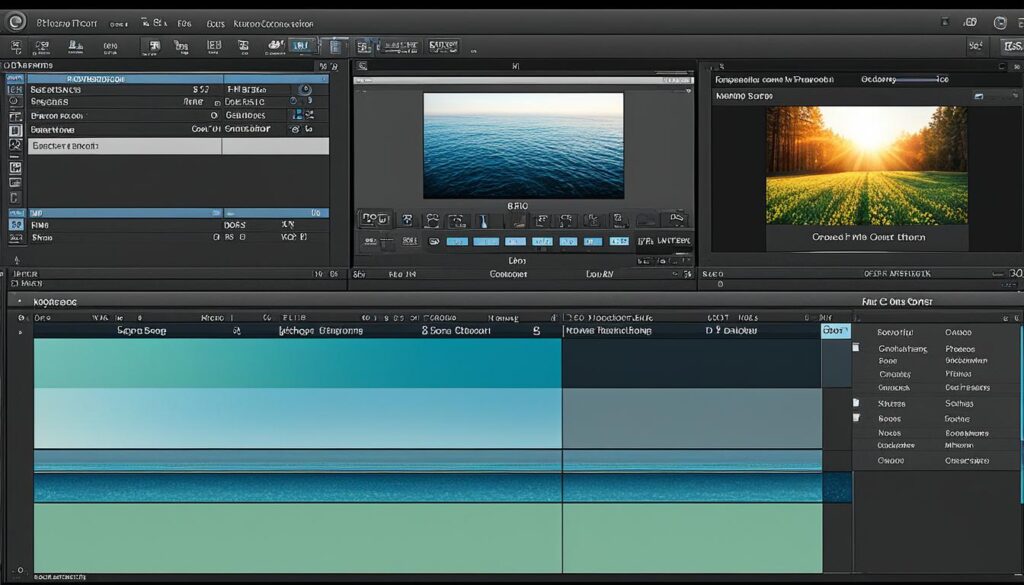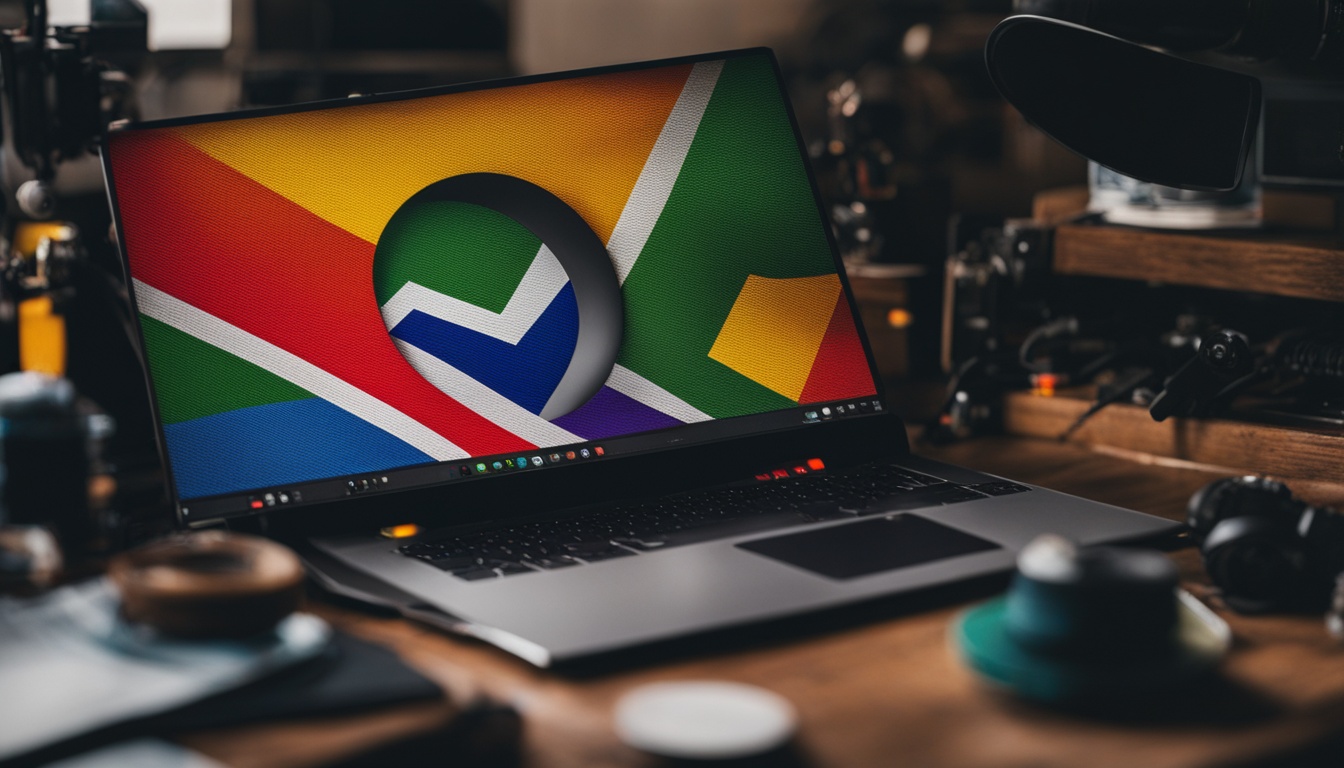In today’s world, video editing is key for making engaging content for businesses and personal brands in South Africa. Learning video editing lets you tell stories, touch emotions, and grab your audience’s attention. This guide covers the must-know techniques, top software, and tips for South Africans to boost their creativity and make great videos.
If you’re just starting or already skilled, this guide is for you. We’ll talk about why video editing matters in today’s digital scene and its benefits for your brand. You’ll find the best video editing software in South Africa and what to think about when picking the right one for you.
We’ll start with video editing basics like the interface, tools, and techniques like cutting and trimming. You’ll learn about advanced stuff like adding transitions, effects, and animations. We’ll also cover colour correction and grading to make your videos look better. Plus, we’ll talk about the role of audio in editing, offering tips on mixing and editing.
To make editing smoother, we’ll give you tips on keeping your projects in order and using shortcuts. We’ll also share advice and tricks for South African creators to overcome local challenges and seize opportunities.
By the end, you’ll know a lot about video editing and be ready to make videos that grab your audience. Whether it’s for social media, YouTube, or professional work, the skills you learn will help you stand out in South Africa’s digital scene. So, let’s get started with Robust Creative Solutions and explore video editing’s power!
Key Takeaways
- Understanding the importance of video editing in today’s digital landscape for businesses and personal brands in South Africa.
- Exploring the best video editing software options available in South Africa and factors to consider when choosing the right tool.
- Mastering the fundamentals of video editing, including essential tools and techniques like cutting, trimming, and sequencing.
- Learning advanced video editing techniques such as incorporating transitions, effects, animations, and colour correction.
- Optimising your video editing workflow with tips for organising projects, using keyboard shortcuts, and time-saving techniques.
- Discovering expert advice and tricks tailored specifically for South African creators to navigate the local market.
Introduction to Video Editing for South Africans
In today’s fast-paced world, video editing is key for both businesses and individuals. South Africa’s creative industry thrives, making video editing a must-have skill. Whether you’re a business owner or a personal brand, learning video editing can boost your projects.
The Importance of Video Editing in Today’s Digital Landscape
Video editing is vital in today’s digital world. With more people watching videos online, making great videos is crucial. Here’s why:
- Engaging content: Good editing grabs and keeps viewers’ attention, making your message stronger.
- Professionalism: Edited videos look professional, which helps your brand look credible.
- Storytelling: Editing lets you tell stories that connect with your audience.
- Emotional connection: With the right visuals and music, videos can make people feel something, building a stronger bond with them.
How Video Editing Can Benefit Your Business or Personal Brand
Video editing offers big benefits for South African businesses and personal brands. Here’s how:
- Showcasing products and services: Edited videos show off what you offer in an engaging way.
- Building brand awareness: Regular, high-quality videos increase your brand’s visibility online.
- Establishing expertise: Informative, edited videos can make you or your business seen as a leader in your field.
- Increasing conversions: Great videos can get more people to visit your site and take action, leading to more sales.
At Robust Creative Solutions, we know how important video editing is today. Our skilled editors are here to help South African businesses and personal brands use video to reach their goals. We can help with corporate videos, social media, or promotional materials, bringing your ideas to life.
Video editing is not just about putting clips together; it’s about telling a story, conveying emotions, and leaving a lasting impact on your audience.
Mastering video editing can take your business or brand to new heights in South Africa’s competitive online world. Use well-edited videos to boost engagement, credibility, and success.
Choosing the Right Video Editing Software
Finding the right video editing software is key for South African creators, whether you’re just starting or you’re an expert. There are many options out there. Think about your skill level, the type of projects you do, your budget, and if it works with your computer. This will help you pick the best software for you.
Popular Video Editing Software Options for Beginners and Professionals
In South Africa, the creative community thrives, and video editing software is crucial. For beginners, iMovie and Filmora are great because they’re easy to use and have basic tools. They’re perfect for learning the basics of video editing quickly.
Professionals often choose top software like Adobe Premiere Pro and Final Cut Pro. These tools have advanced features and let you control every detail. DaVinci Resolve is also popular for its colour grading skills among South African pros.
Factors to Consider When Selecting Video Editing Software
When picking video editing software, think about what you need and what you want to achieve. Keep these points in mind:
- Skill level: Check if you’re a beginner or an expert and pick software that matches your level.
- Project complexity: Think about how complex your projects are to make sure the software can handle them.
- Budget: Look at your budget and choose software that fits without missing out on important features.
- Compatibility: Make sure the software works with your computer and other equipment.
By considering these factors, you can find the best video editing software for you as a South African creator.
Recommended Video Editing Software for South Africans
Here are some top video editing software picks for South Africans:
| Software | Skill Level | Operating System | Key Features |
|---|---|---|---|
| iMovie | Beginner | macOS | User-friendly interface, basic editing tools, built-in templates |
| Filmora | Beginner | Windows, macOS | Easy-to-use interface, lots of effects and filters, screen recording |
| Adobe Premiere Pro | Professional | Windows, macOS | Top-level, advanced editing tools, works well with other Adobe software |
| DaVinci Resolve | Professional | Windows, macOS, Linux | Great for colour grading, works well with others, has a free version |
The best video editing software for you is based on your needs and what you like. Take time to check out different options, try demos or free trials, and get advice from the South African video editing community. With the right tools and creativity, you can make videos that really grab your audience.
Mastering the Fundamentals of Video Editing
To make videos that grab your audience’s attention, you need to learn the basics of video editing. Start by getting to know the key concepts and techniques that are the building blocks of this art. This knowledge will help you make videos that clearly share your message and stick with your viewers.
Understanding the Video Editing Interface and Tools
When you open your video editing software for the first time, it might look like a lot to take in. But, most editing tools have a similar layout, making them easier to get used to. Take some time to look around and find the main parts like the media library, timeline, and preview window. Learn how to use tools for adding media, organizing files, and making precise edits.

Robust Creative Solutions, a top video production company in South Africa, stresses the need to get to know the editing interface well. Their skilled editors suggest spending time to learn what each tool does and how it can improve your editing. This knowledge lets you work better and bring your ideas to life more effectively.
Essential Video Editing Techniques: Cutting, Trimming, and Sequencing
After getting to know the editing interface, it’s time to learn the key techniques. Cutting, trimming, and sequencing are the main skills every editor should know.
- Cutting: Cutting means removing parts of footage you don’t need, like pauses or mistakes. By picking the best takes and cutting out the rest, you make your video more engaging and to the point.
- Trimming: Trimming lets you adjust the start and end of your clips for smooth transitions between shots. This keeps your video flowing well and keeps your viewers interested.
- Sequencing: Sequencing is arranging your edited clips in a way that tells a clear story. Think about the pace, flow, and emotional effect you want to create as you put your video together.
“Mastering the art of cutting, trimming, and sequencing is the key to creating compelling videos that resonate with your audience. These techniques help you turn raw footage into a polished, impactful video.” – Sarah Botha, Senior Editor at Robust Creative Solutions
As you practice these key editing techniques, you’ll get better at noticing details and understanding how to tell stories. Remember, editing is a process that takes time, so don’t hesitate to try new things, learn from mistakes, and improve your skills. With hard work and practice, you’ll be able to make videos that really connect with your audience and leave a mark.
Advanced Video Editing Techniques for Engaging Content
Once you’ve learned the basics of video editing, it’s time to dive into advanced techniques. These can make your content stand out. At Robust Creative Solutions, a top video production company in South Africa, they share their expertise in these areas.
Incorporating Transitions, Effects, and Animations
Transitions, effects, and animations add excitement and guide viewers through your story. They make your videos more interesting. Using cuts, fades, and dissolves between scenes makes the flow smooth. Effects and animations can make your videos pop and support your message.
Here are some examples of how to use these techniques:
- Use a fade transition to show time passing or a change in setting
- Add a motion blur effect for fast action scenes
- Include animated text or graphics to highlight important points

Colour Correction and Grading for Enhancing Visual Appeal
Colour correction and grading are key in making your videos look great. Colour correction balances exposure and ensures shots match. Colour grading adds a style to your video, setting the mood and evoking feelings.
Colour is a powerful tool in video editing. It can influence emotions, create atmosphere, and guide the viewer’s attention. Mastering colour correction and grading techniques is essential for creating professional-looking videos.
Here are some tips for working with colour:
- Use colour correction for consistent exposure and white balance
- Apply creative colour grades to set a mood or style
- Use colour to highlight important elements or create contrast
Working with Audio: Mixing, Editing, and Synchronisation
Audio is crucial in video editing. It needs to be balanced and clear. Audio mixing balances levels and removes noise. Editing trims and arranges sound clips with visuals. Synchronisation makes sure the audio and video match perfectly.
Here are some audio editing tips:
| Technique | Description |
|---|---|
| Audio mixing | Balance levels, remove background noise, and ensure clarity in dialogue and sound effects |
| Audio editing | Trim, cut, and arrange sound clips to match the visuals |
| Synchronisation | Ensure that the audio and video are perfectly aligned for a seamless viewing experience |
Mastering these advanced techniques can make your videos engaging and professional. Whether you’re new or experienced, adding transitions, effects, animations, colour correction, colour grading, and audio editing will improve your videos.
Optimising Your Video Editing Workflow
Mastering your video editing workflow is key to making high-quality content quickly and meeting deadlines. By using good organisation, shortcuts, and saving time, you can make your editing faster and more efficient. This boosts your productivity.
According to Postpace, a good video editing workflow has four main stages. These are organising footage, rough cut, fine cut, and final cut. Breaking your workflow into these steps helps you manage your projects better and keeps things moving smoothly from start to finish.
Tips for Organising and Managing Your Video Projects
Good project management is vital for a smooth video editing workflow. Start by setting up a clear folder structure for your project. Use clear file names that show what the file is and its version. This makes finding specific files easy.
Use your editing software’s tools like bins and markers to sort your footage. Filestage suggests setting clear goals for your video project. This includes the message, target metrics, look and feel, and technical needs. Having these goals early helps plan your editing and use resources well.
Working with video engineers to estimate time for your footage helps predict project scope. Tools like Dropbox and Postpace help manage and share raw video clips, making teamwork in post-production smoother.
Keyboard Shortcuts and Time-Saving Techniques
Keyboard shortcuts change the game in video editing. Most editing software, like Adobe Premiere Pro and DaVinci Resolve, has shortcuts for common tasks. Learning and customising these shortcuts cuts down on time spent on repetitive tasks.
There are also ways to save time in editing. Social Channel Studios suggests using batch processing, proxy editing, and rendering previews. Batch processing applies effects to many clips at once. Proxy editing uses lower-resolution footage for faster work. Rendering previews lets you quickly check edits without waiting for real-time playback.
| Video Editing Software | Popular Keyboard Shortcuts |
|---|---|
| Adobe Premiere Pro |
|
| DaVinci Resolve |
|
A great video editing workflow breaks projects into seven steps, from organising footage to getting feedback and finalising the edit.
Using these strategies, shortcuts, and time-saving tips can greatly improve your video editing workflow. The key is to balance efficiency with creativity. This way, you can make amazing content while meeting deadlines.
Video Editing Tips and Tricks for South African Creators
As a South African creator, you can boost your video editing skills. This will help you grab your audience’s attention with great content. Focus on storytelling that speaks to your local viewers. This way, you can make videos that stick with people.
Start by making storytelling your top priority. Use visuals and voices that feel real and connect with your viewers. Try out different editing styles and effects to see what suits your content and audience best.
Working together is important for growth. Connect with other South African creators, share tips, and learn from each other. A supportive community can help everyone improve their editing skills and make content that hits the mark.
“Collaboration is the fuel that drives creativity and innovation in the South African creator community. By working together, we can push the boundaries of what’s possible in video editing and storytelling.” – Thabo Mokoena, Founder of Robust Creative Solutions
Keep your skills fresh by following the latest in video editing. Go to workshops, join online groups, and keep learning. This will help you stay ahead in the fast-changing digital world.
| Video Editing Tip | Benefit |
|---|---|
| Focus on storytelling | Connects with audience on a deeper level |
| Experiment with editing styles | Finds what works best for your unique content |
| Collaborate with other creators | Enhances skills and fosters supportive community |
| Stay updated with trends and techniques | Remains competitive in the digital landscape |
Remember, you have a special view and voice as a South African creator. Use these tips to make your content better, engage your viewers, and leave a mark online.
Conclusion
Video editing is now key for South Africans in the digital world. It’s vital for businesses, personal brands, and those who want to make films. The HSAD video editing project shows that learning to edit videos can lead to great creative solutions.
Video editing is very important, say 82% of film pros. It keeps stories clear and touching. Experts say timing is everything, with 91% stressing the need for the right cuts. Smooth transitions keep viewers hooked, with 70% more likely to watch videos with them.
Sound editing is also vital, affecting 65% of viewers and 88% of pros. It sets the mood and stirs feelings.
Starting your video editing journey in South Africa means always learning and trying new things. Use video editing to be creative, tell stories, and touch your audience. With hard work and practice, you can make content that speaks to people everywhere.
By improving your video editing skills, you’ll help the South African creative industry grow. You’ll open doors to success in the digital world. So, get involved, see what you can do, and let your video editing passion show in every project. The future of video editing in South Africa looks bright, and you can be part of it.






